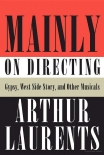Mainly on Directing, Arthur Laurents [best books for students to read TXT] 📗

- Author: Arthur Laurents
Book online «Mainly on Directing, Arthur Laurents [best books for students to read TXT] 📗». Author Arthur Laurents
Why did I go to London to take over West Side Story? Jerry had come to help when I asked, I went when he asked. Happily, I wouldn't have two problems I had the last time I directed an English company of an American musical, Gypsy with Angela Lansbury: teaching the very insular English actors how to speak American and implanting them with energy. Twenty-five years later, the English (and Australians) could speak regional American and were capable of burning up the stage. Moreover—an important credential for playing West Side—there had been a large influx of people of color in Britain, so they all knew about prejudice, including their own. What that company didn't know was how to use what they did know in their performances—largely because they had been directed by an American choreographer practiced in putting out companies of West Side Story as by the established numbers.
The dancing was typical of what was wrong. It was advertised as Jerome Robbins's choreography, but it wasn't—it was his steps. What the steps meant, why they were doing them, the dancers were never told. The same was true of the songs, and as for the book—well, Maria and Tony were in love, Riff and Bernardo didn't like each other, and Anita was easily upset but had great extension. On the plus side, they were young, they were extremely attractive, they sang and danced beautifully, and they couldn't have been hungrier for help. In two weeks, they learned an enormous amount—and so did I.
From the misbegotten 1980 revival, I knew the scenery and costumes needed to be changed. The scenery, I couldn't do anything about, but I could light it differently. Directors should get down on their knees in gratitude to a lighting designer like Howell Binkley who did Gypsy with me and is doing the new West Side Story I'm preparing. The costumes, I could do something about—not enough, but something. It may have been authentic in 1957 for gangs to wear jackets to a dance, but in 1998, they looked like chorus boys. Out went most of the jackets, in came windbreakers and rolled-up shirt sleeves. With the girls, out came the scissors. Skirts were slashed from calf length to knee length and higher; necklines were lowered. It all helped.
A cardinal sin was committed: I fiddled with the choreography—beginning at the beginning with the first dance, the Prologue. A Jet, as choreographed, reaches over a wall to whack a Shark with a sack of flour; in London, he hit him over the head with a blackjack. I fiddled more with the dialogue—safe territory because that was mine. Most effective of all, and truest to life, Tony and Maria were as sexual as possible. They had absolutely beautiful voices, but to sing “Tonight” together, they had to get their tongues out of each other's mouth. In their bridal-shop scene, marriage seemed essential if what they were about to do was fruitful.
It was a very happy time for the cast, for me, and for the producers. I also learned about the pitfalls in West Side Story: some brought on by the passage of time were anticipated, some that I had thought were there weren't, some I hadn't realized were there were always there. More than anything else, I learned that what was most needed for any new production was a fresh, original look at the show. What that was, I had no idea. In 1998 in London, it didn't matter. The audience was too delighted to see the show done again and with passion and excitement to boot. In 2006 in New York, a new idea mattered.
In that year, there was a frenzied campaign for a revival of West Side Story on Broadway in 2007. Why? Presumably, to honor its fiftieth anniversary, but not incidentally that anniversary was a good selling point, not only for Broadway but for a subsequent tour, both of which could mean a lot of money. Money was the first priority in the country. Well, isn't theatre supposed to reflect the time?
There were two certified choreographers to choose from for the golden dancing goose, but who to direct? Who to be responsible for the production? The question was unsettled, settled, unsettled in meeting after meeting of the rights-holding estates until it was fortunately too late to get any production ready in time for the anniversary. During all the backing-and-forthing, however, something remarkable happened. That much-needed-and-wanted fresh, original approach to a revival had surfaced. It came from Tom Hatcher.
Tom always had a project going in addition to his day job. The most lasting was the beautiful twelve-acre private park he created in Quogue, where we would sit on a special bench every day and talk. Even now, every day I'm in Quogue, I sit on that bench and talk to him.
A less grand project was his prescient desire to learn Spanish. He worked hard at it, spending two weeks in Ecuador, where Quito has the best Spanish-teaching school in the world. As he became fluent, he travelled South America avidly and regularly. I went with him occasionally—love is togetherness, but it benefits from separation now and then. In Buenos Aires, we became friends of F&F—Federico and Fernando, agents, translators, facilitators, entrepreneurs. They knew everybody, were known by everybody and not quite placeable by anybody except those at the American embassy who knew Federico in his other life as the Argentinean cultural and legal adviser. In the theatre, anything in English went into Spanish courtesy of F&F. They were eager to get a production of West Side Story done in South America, in Buenos Aires. One was done, but not in Buenos Aires, in Bogotá, and not by them.
I had been to Bogotá with Tom, but when that West Side was done by a local company in Spanish, he was there alone on opening night. He reported back on the production in excited detail. What most fascinated him was that the hometown language being





Comments (0)